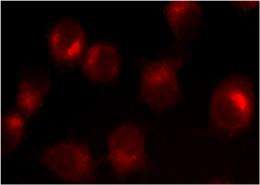Turning the spotlight on drug-resistant tumors

Molecular probes that can illuminate cancer cells are often invaluable tools in the fight against the disease. The latest addition to this group is a family of fluorescent probes that can highlight a particularly pernicious kind of tumor cell: those resistant to anticancer drugs. The international team of scientists behind the research, led by Hiroshi Abe at the RIKEN Advanced Science Institute in Wako, Japan, and Ralf Morgenstern at the Karolinska Institute in Stockholm, Sweden, say that their discovery could help expedite research efforts to defeat these drug-resistant tumors.
The probes work by targeting a family of enzymes called glutathione transferases (GSTs). These enzymes play a variety of roles in healthy cells, including protecting the cell from oxidative stress by labeling harmful molecules with a glutathione tag. This tag marks the molecule for rapid export out of the cell. But in certain cancer cells, GSTs are produced in elevated amounts, where they are able to tag many anticancer drugs in the same way. As a result, the drug is pumped away before it can kill the cell. Finding ways to block GSTs is therefore an active area of cancer research since a probe that can reveal the level of GST activity inside a living cell could prove a very useful tool in the search.
The team’s fluorescent probes exploit the GSTs well-known molecular mode of action. The GST enzymes target molecules—such as anti-cancer drugs—by attacking an electron-poor point in its structure and attaching the glutathione label to it. Using a series of known fluorescent molecules, Abe, Morgenstern and colleagues added to them an electron-poor arylsulfonyl group ripe for attack by a GST enzyme. The arylsulfonyl group also has the effect of suppressing the fluorescence; but, as GST attacks, it breaks the probe in two which releases the fluorophore and instantly illuminates the cell.
The researchers demonstrated that they could use their probes to quantitatively measure very low levels of GST in cell extracts. Using a fluorophore known as cresyl violet, they were also able to image GST activity inside living cells (Fig. 1). According to Abe, the researchers already have plans to improve the performance of their probes, making them even more sensitive.
“By fine-tuning the chemical reactivity of the protecting arylsulfonyl group, we will improve the signal to background noise ratio for improved imaging,” he says. “By re-designing the fluorescent compound, we can also achieve GST subtype selectivity,” he adds.
More information: Zhang, J., et al. Synthesis and characterization of a series of highly fluorogenic substrates for glutathione transferases, a general strategy. Journal of the American Chemical Society 133, 14109–14119 (2011).
















